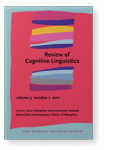Productivity of Spanish verb–noun compounds
Patterns of metonymy and metaphor
This study examines Spanish verb–noun compounds in terms of the role played by, and the relationship between, metonymy and metaphor in generating them. After exploring different referent types denoted by Spanish verb–noun compounds such as instrument, agent, place, plant, animal/insect, and causer event, sample examples are analyzed in each referent type for their conceptualization patterns. The analytical tools are based on the notion of domain-internal and domain-external conceptual mappings for metonymy and metaphor, respectively, as well as on the model proposed in the Combined Input Hypothesis for the analysis of metaphors involving multiple inputs. The analysis of the data shows that there are at least four metonymic and metaphoric patterns involved in Spanish verb–noun compounds and that these patterns are productive. The four patters are: (i) only metonymy is involved; (ii) target-in-source metonymy is derived from metaphor; (iii) metaphor is derived from target-in-source metonymy, and (iv) metonymy is derived from a metaphor which is derived from metonymy. This study proposes that these four types of metonymic and metaphoric patterns mediate the production of novel Spanish verb–noun compounds. The implication of this finding is that the more complex the cognitive operations involved in verb–noun compounds, the less predictable the meaning of the compound will be for the language users who first hear them; but once learnt, the meaning of the compound is stored as a whole unit in their mental lexicon. An analysis of a larger corpus of data in future studies will reveal a more comprehensive picture of the relational patterns involved in Spanish verb–noun compounds.
Cited by (2)
Cited by two other publications
Güemes, Mercedes, Carolina Gattei & Alejandro Wainselboim
2019.
Processing verb–noun compound words in Spanish: Evidence from event-related potentials.
Cognitive Neuropsychology 36:5-6
► pp. 265 ff.

This list is based on CrossRef data as of 16 july 2024. Please note that it may not be complete. Sources presented here have been supplied by the respective publishers.
Any errors therein should be reported to them.
